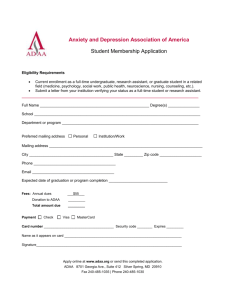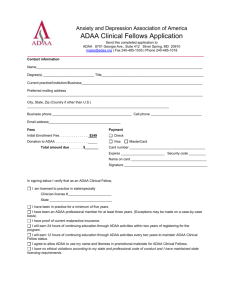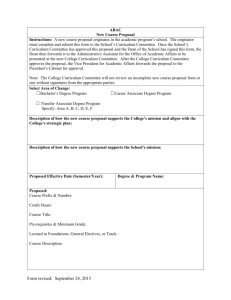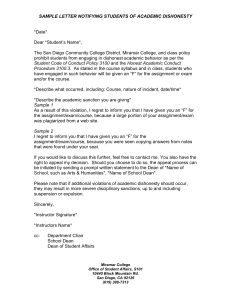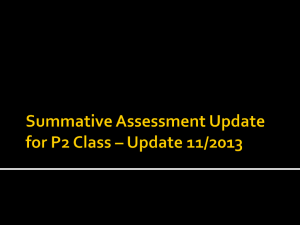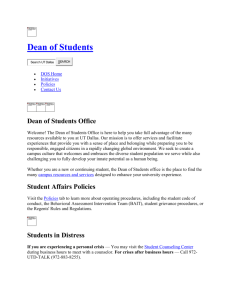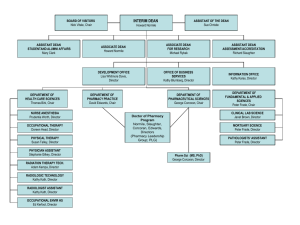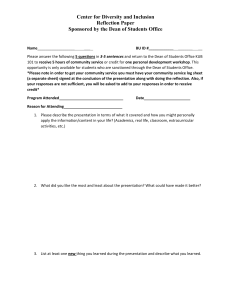Programmatic Assessment Plan
advertisement
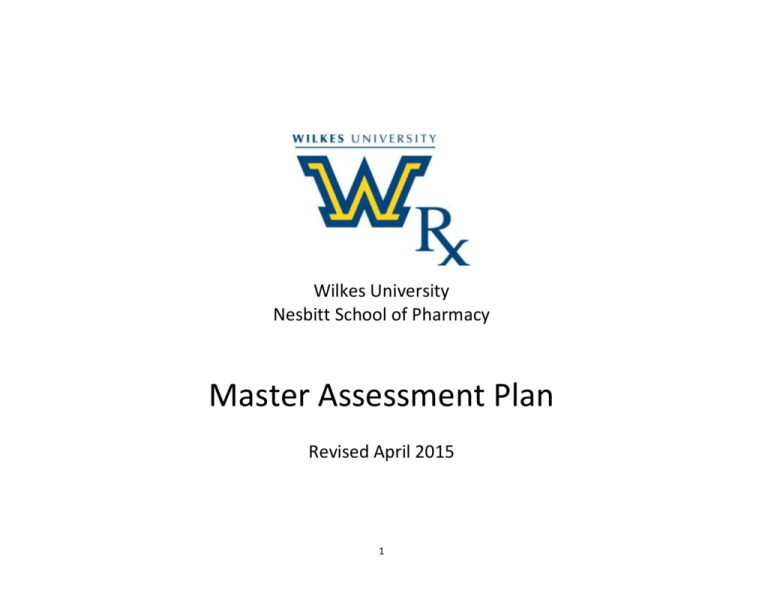
Wilkes University Nesbitt School of Pharmacy Master Assessment Plan Revised April 2015 1 Table of Contents Purpose .......................................................................................................................................................................................................................... 3 Mission Vision Values .................................................................................................................................................................................................... 3 Student Affairs Related Assessments ............................................................................................................................................................................ 5 Scholarship .................................................................................................................................................................................................................... 5 Curricular Related Assessments .................................................................................................................................................................................... 6 Assessment Notes ......................................................................................................................................................................................................... 7 School of Pharmacy Stakeholders ................................................................................................................................................................................. 8 Definitions ................................................................................................................................................................................................................... 10 Strategic Plan ............................................................................................................................................................................................................... 11 2 The revision process for the Master Assessment Plan 2014 was in response to a number of internal and external factors, including evolving demands from Accreditation Council on Pharmacy Education (ACPE), new Wilkes educational outcomes, updated Center for Advancement of Pharmacy Education (CAPE) 2013 outcomes, and proposed accreditation standards 2016 (which were first made available in draft form in January 2014). This plan replaces the School of Pharmacy Master Assessment Plan 2010 version 5. This plan was generated by the Acting Assistant Dean for Academic Affairs and Assessment and thoroughly vetted through the Assessment Committee with comments from the faculty of the School of Pharmacy and the Executive Committee. Purpose The purpose of the revised Master Assessment Plan is to serve as a guide for all assessment activities related to the operations of the School of Pharmacy. This process helps ensure continuous quality improvement for the Doctor of Pharmacy program at Wilkes University. Mission Vision Values The Mission of the School of Pharmacy is to develop pharmacists who will provide high quality health care and to make meaningful contributions to the science and practice of pharmacy. The Vision of the School of Pharmacy is to be recognized as an exceptional pharmacy program through innovative education, contemporary practice, and valuable scientific contributions. Values Teamwork Professionalism Lifelong Learning Cultural Competency Personalized Attention Community Engagement 3 Dean Nesbitt School of Pharmacy School of Pharmacy Executive Committee Dean Assistant Dean for Academic Affairs and Assessment Assistant Dean for Student Affairs Chair of Pharmacy Practice Chair of Pharmaceutical Sciences Director of Experiential Learning Assistant to the Dean (non-voting) Assistant Dean for Academic Affairs and Assessment Assistant Dean for Student Affairs Administrative Assistant Assistant to the Dean Chair of Pharmaceutical Sciiences Chair of Pharmacy Practice Administrative Assistant Director of Experiential Administrative Assistant Director of Residencies Pharmacy Librarian Practice Faculty Laboratory Director Administrative Assistant Science Faculty Experiential Coordinator Figure 1 Organizational Chart 4 Fiscal Scholarship Student Affairs Related Assessments Assessment Standard Map (2016) 1, 17 1 1 1 1, 16 1, 12 Cycle Accountable Review Process Notification Annual Annual Semester Every semester Annual Annual P3 APPE grades (P/F/H) Co-curricular evaluation and Professional Development 2, 4, 13 4, 12 Every rotation Annual Student Affairs Student Affairs Student Affairs Advisor Student Affairs Care Lab Coordinator Student Affairs Exp Director ADSA Advisors ADSA ADSA ADSA ADSA ADSA ADSA and ADAA ADSA ADSA Early Alert Notification 17 Ongoing ADSA ADSA ADSA ADSA ADSA Care Lab Coordinator Exp Director Dean through Student Senate, Experiential Faculty ADSA, Advisors ADSA Scholarly productivity 19 Annually through SER and evaluations for faculty and staff Chairs Chairs Dean Budget Process 23 Annual Dean, Chairs Executive Dean Progression rates Withdrawal rates Academic Probation rates GPA Admissions info (PCAT, SAT, GPA) OSCE 5 Curricular Related Assessments Overall Assessments Assessment Standard Map (2016) Cycle Accountable Review Process Notification SoP Graduating Survey IPE outcomes assessment 4, 11 11 Annual Annual Exec Curriculum ADAA ADAA IPPE/APPE Capacity Chart Writing Across the Curriculum Map of content to courses (Appendices) PCOA NAPLEX pass rates NAPLEX Areas MPJE AACP Graduate Survey (most recent P4 class) AACP Preceptor Survey AACP Faculty Survey AACP Alumni Survey (of last five graduating classes) Student Response Survey 22 1 10 Annual Every three years One Map Every Year Dean Chair Pharm Practice Exp Director ADAA Curriculum Experiential Curriculum Curriculum ADAA ADAA ADAA 1, 10, 12 1 1, 10 1, 10 9, 10, 14, Annual – P3s Annual Annual Annual Annual ADSA/ADAA ADAA ADAA ADAA ADAA Exec Assessment Exec Exec Curriculum Exec Curriculum ADAA ADAA ADAA ADAA ADAA 20 9, 10, 23 15 Every other year (even) Annual Every other year (odd) ADAA ADAA ADAA Experiential Exec Exec Curriculum ADAA ADAA ADAA 19, 20 Every course Chairs faculty ADAA APPE – PxDx Report Noel Levitz Student Satisfaction Inventory 13 14 Annual Every other year (odd) Experiential Office of Information, Analysis, & Planning ADAA ADAA Current Strategic Plan Measures (i.e. formative assessment of mission/vision/objectives) Comprehensive programmatic review 7, 24 Annual Objectives Every three years – initiatives Semi-annual retreat (4 retreats = 1 comprehensive cycle Chairs/Institution al Assessment Exp Director Director Institutional Assessment ADAA Assessment Strategic Planning ADAA ADAA with Exec Assessment ADAA 1-25 6 Assessment Notes The student affairs related assessments focus on enrollment and progression measures for students. The office of the Assistant Dean for Student Affairs maintains most of the records. The use of OSCEs in the P3 care lab will serve as one of the pre-APPE assessments. While it relates directly to student progression (student affairs), it also relates to curricular effectiveness leading up to APPEs (academic affairs). Co-curricular evaluation involves analysis of student involvement, leadership, and professional attitudes and behavior. The Dean will solicit some of this information primary through student senate. The use of the electronic portfolio, E-Value, will capture reflections and identify development in students and will be overseen by advisors. The scholarship assessment is done primarily through the annual review of faculty members. The department chairs will solicit and evaluate the scholarly productivity. The curricular related assessments focus on curricular content and quality issues. The office of the Assistant Dean for Academic Affairs and Assessment maintains these assessments. The curriculum committee will be charged each year to review a specific Accreditation Appendix, with the comprehensive review being completed every three years. The semi-annual programmatic review is designed to complete a full evaluation of all aspects of the PharmD program every two years. Since educational outcomes are continuously monitored, a larger focus of the review will be on the structure and process to promote achievement of educational outcomes. Assessment Notification Policy The purpose of the policy is to determine a clear course of action for identifying and referring abnormal assessment results to responsible parties so that meaningful change can be implemented, if applicable. The policy specifies that any person (or committee) in a position to review results of an assessment measure shall internally determine a threshold for considering the result abnormal or inadequate. It is understood that this threshold may change with committee turnover. When an abnormal or inadequate assessment result has been identified, the person shall notify the appropriate Assistant Dean’s office (Academic Affairs [ADAA] for curricular assessments or Student Affairs [ADSA] for student-related assessments). As the central hub for collecting assessment results, the ADAA or ADSA office will consider the abnormal or inadequate result along with all other assessment measures and forward, when applicable, a recommendation to a person or committee for consideration and action to address the concern. This “closes the loop,” as future assessment measures will identify change based on the action of the responsible person or committee. It is expected that this process will operate seamlessly as at least one of the Assistant Deans serves on all standing committees in the School of Pharmacy. 7 School of Pharmacy Stakeholders Who Dean Meets NA Reports To Provost and SoP Assistant Dean for Student Affairs NA Dean Assistant Dean for Academic Affairs NA Dean Academic Departments Pharmacy Practice Pharmaceutical Sciences Monthly Executive Committee and SoP Faculty Executive Committee Monthly SoP Faculty and University Standing Committees Monthly Executive committee and SoP Faculty Curriculum Student Affairs Responsibility Annual and projected budget, staffing, and facility management. All aspects of admission, progression, and graduation. Maintains data sets relevant to student success. All aspects of programmatic assessment and accreditation processes. Provides assistance with data analysis and tool development and maintains relevant data sets. Each department formulates own mission statement which is in support of the role, mission, and goals of the SoP. Assessment is focused on mission, meeting department needs, faculty development and the development and delivery of the professional curriculum. In collaboration with Dean, provides fundamental responsibility and oversight for program success. Develops annual charges for standing committees based on end-ofyear reports from committees and departments. Reviews and responds to issues and situations as needed. Committees address annual charges form Executive Committee Continually appraises and evaluates the professional and pre-professional pharmacy education curriculum, outcome statements, curricular maps, and develops recommendations for curricular revisions to assure optimal student learning and outcomes. Reviews and approves course changes and forwards recommendations to University curriculum committee. Develops policy and makes recommendations pertaining to standards for professional and pharmacy student recruitment and admission to the existing program. Also develops policy for academic standards related to curricular progression and completion. Establishes recommendations 8 Strategic Planning Assessment Student Senate Monthly Dean, Student Body Ad Hoc Taskforces As needed Varies Semiannual Program Review At the end of SoP Faculty, each semester staff, and students for awarding professional scholarships, awards, prizes, and oversees the awards process. Develops, monitors, refines, and reports on the SoP Strategic Plan. Works with Assessment Committee on determining measures of success. Oversees assessment measures for all aspects of the program. Works with Strategic Planning committee by offering assessment measures for annual strategic objectives. Made up of six elected representatives from each class, club presidents, and class officers. Elects student representatives to SoP standing committees, tracks some co-curricular activities of the student body, oversees Nesbitt Cup volunteer competition, and determines financial support for student clubs. Supports the work of committees and individuals as needed. Particularly useful when expertise across committees and/or departments is required. Reviews ¼ of the entire program each semester. Generally evaluates: Student Affairs related assessments (Standards 14-18, 2016), Facilities and Infrastructure (Standards 5-9, 2123), Faculty and Staff factors (Standards 18-20), and other Global Curricular Issues (Standards 1-4, 10-13, 24-25) 9 Definitions Assessment: measurement with intent to improve. Direct Assessment Evidence: data reflecting the outcome itself; the knowledge, skill, or attitude is tested observed or measured directly (e.g. exam scores, writing assignments, portfolios of student work, faculty publications, grant awards). Evaluation: the broad process of utilizing many pieces of assessment data to form judgments about the quality and effectiveness of the Doctor of Pharmacy program at Wilkes University. Formative Assessment: the process of gathering information about work in progress of the purpose of making informed changes to the work. Impact Measures: data collection methods used to measure the long-term effects of a project, course, or program. Implementation Measures: data collection methods used to measure performance the execution of a project, course, or program. Individual Assessment: assessment to ensure individuals (students and faculty) are meeting desired outcomes. Institutional Assessment: assessment of the institution (Wilkes University) as a whole to ensure the achievement of the School of Pharmacy’s mission and goals (e.g. accreditation self-study report, program review, student retention and progression). Mapping: using a visual format for showing how various entities or variables relate. For example, linking content in courses to the intended learning outcomes. The purpose of mapping is to quickly identify strengths or gaps in the relationship being considered. Master Assessment Plan: the document that outlines the plan for the collection, evaluation, and use of assessment data for the School of Pharmacy to ensure the mission and goals are accomplished. Peer Comparison: The process of using data from groups designated as peers for the purpose of comparison. Program Assessment: assessment of an academic degree program (PharmD) using aggregate data collected at various phases in the program from students, alumni, faculty, employees, and others to ensure that graduating students are ready for careers as entry-level pharmacists. Programmatic Outcomes: measures of programmatic success. Goals that describe how a program will be different because of selected initiatives. Summative Assessment: assessment that occurs at the end of a course, project, or program in order to measure outcomes. Trend Analysis: analysis of data sets over time in order to determine patterns of skill, thought, or behavior. SER (Self Evaluation Report): An annual report generated by faculty as part of the annual evaluation process. The SER is given to department chairs. Student Learning Outcomes: measures of student success. Goals that describe how students will be different because of a learning experience. 10 Strategic Plan STRATEGIC INITIATIVES: 2013-2016 1. 2. 3. 4. 5. 6. Evolve to remain innovators in education capable of attracting high quality students. Create a culture of research and scholarship within the School of Pharmacy Assess viability of university based practice programs. Develop strategic collaborations with universities, health care systems, insurance providers, pharmacies, pharmaceutical industry, etc. Embrace and enhance inter-professional education Enhance culture of integrative assessment. STRATEGIC OBJECTIVES: Academic Year 2013-2014 1. Develop a plan to evaluate the content, format, and sequence of the curriculum. (SI 1,5,6) o Accountable -Curriculum and Assessment o Timeline -Complete plan by end of academic year 2. Craft a business plan to implement a center for information mastery. (SI 1,3,4) o Accountable -Jon Ference and team o Timeline -End of academic year 3. Craft a business plan to implement a center for medication therapy management. (SI 1,3,4) o Accountable -Eric Wright and team o Timeline -End of academic year 4. Identify and engage external sources of funding. (SI 1,2,4) o Accountable -Dean, Exec, Individual faculty o Timeline -Ongoing 5. Develop marketing plan to attract high quality students. . (SI 1) o Accountable -SOP point person with Melanie Mickleson, Jack Chielli, &/or Admissions o Timeline -End of academic year 6. Determine factors affecting student marketability post-graduation. . (SI 1) 11 o o Accountable Timeline -Exec To coincide with career fair (employer surveys) 7. Create a report which documents current Interprofessional elements in the curriculum and identify if areas of enhancement are needed. (SI 1, 5) o Accountable -Curriculum o Timeline -End of academic year 8. Pilot Spanish Specialty Track. . (SI 1) o Accountable -Curriculum o Timeline -End of fall semester 9. Develop formalized FAQ sheet for Advisors. . (SI 1) o Accountable -Assistant Dean (Student Affairs) o Timeline End of academic year 10. Consider non-rolling admissions for PPGS and utilization of PharmCAS for transfers. (SI 1) o Accountable -Student Affairs o Timeline -End of academic year 11. Assess need to revise programmatic objectives (outcomes). . (SI 1,6) o Accountable -Assessment / Curriculum o Timeline End of fall semester 12. Assess processes of assessment by capturing timelines and monitoring change in response to assessment activities. (SI 1,6) o Accountable -Assessment o Timeline -Ongoing 13. Implement faculty development programs for teaching and research. (SI 1,2) o Accountable -Assistant Dean for Academic Affairs and Assessment o Timeline -Ongoing 14. Foster faculty collaborations in scholarship. (SI 2) o Accountable -Chairs, Executive Committee, Individual Faculty 12 o Timeline -Ongoing 15. Increase student participation in scholarly activities. (SI 2) o Accountable -Dean, Chairs, Individual Faculty o Timeline -Ongoing 16. Sustain and seek opportunities to promote the cultural competency of faculty, staff, and students. (SI 1) o Accountable -Dean, Individual Faculty o Timeline -Ongoing 13 STRATEGIC OBJECTIVES: Academic Year 2014--‐2015 1. Evaluate the curriculum for “critical items” and create a tool of speicfi measures that define success for these items (SI1) a. Accountable: Assessment Committee 2. Create a formal assessment plan formal assessment plan for evaluating and addressing emerging concerns (student employment challenges, direct competition, facilities, etc) (SI1) a. Accountable: Strategic Planning Committee 3. Evaluate and propose an alternate sequence to the School of Pharmacy curriculum. (SI1) a. Accountable: Curriculum Committee 4. Support and explore curricular tracks/concentrations (Spanish, Leadership, etc). (SI1) a. Accountable: Curriculum Committee 5. Evaluate the atmosphere and potential for a satellite school in a secondary location. (SI1) a. Accountable: Executive Committee 6. Develop a plan to increase the resources for faculty and students to conduct, present, and be exposed to meaningful research. (SI2) a. Accountable: Dean and Department Chairs 7. Create a list of possible collaborations or partnerships for which the School may pursue in the next 3-5 years. (SI3) a. Accountable: Executive Committee 8. Create a subcommittee in charge of coordinating and assessing interprofessional activities at all levels of Pharmacy education (SI5). a. Accountable: Chair, Department of Pharmacy Practice 9. Develop a plan for implementing and evaluating pre-APPE assessments (OSCE, PCOA, etc) (SI6) a. Accountable: Assessment Committee 10. Decide if the School will adopt examination software and create a draft plan for implementation and assessment. (SI6). o Accountable: Executive Committee 14 Reserved for STRATEGIC OBJECTIVES: Academic Year 2015-2016 15
